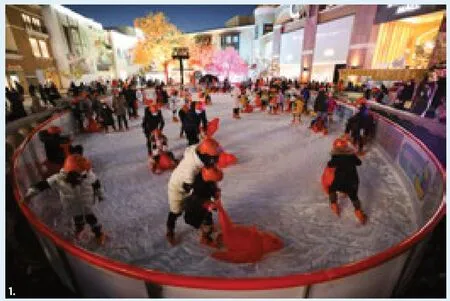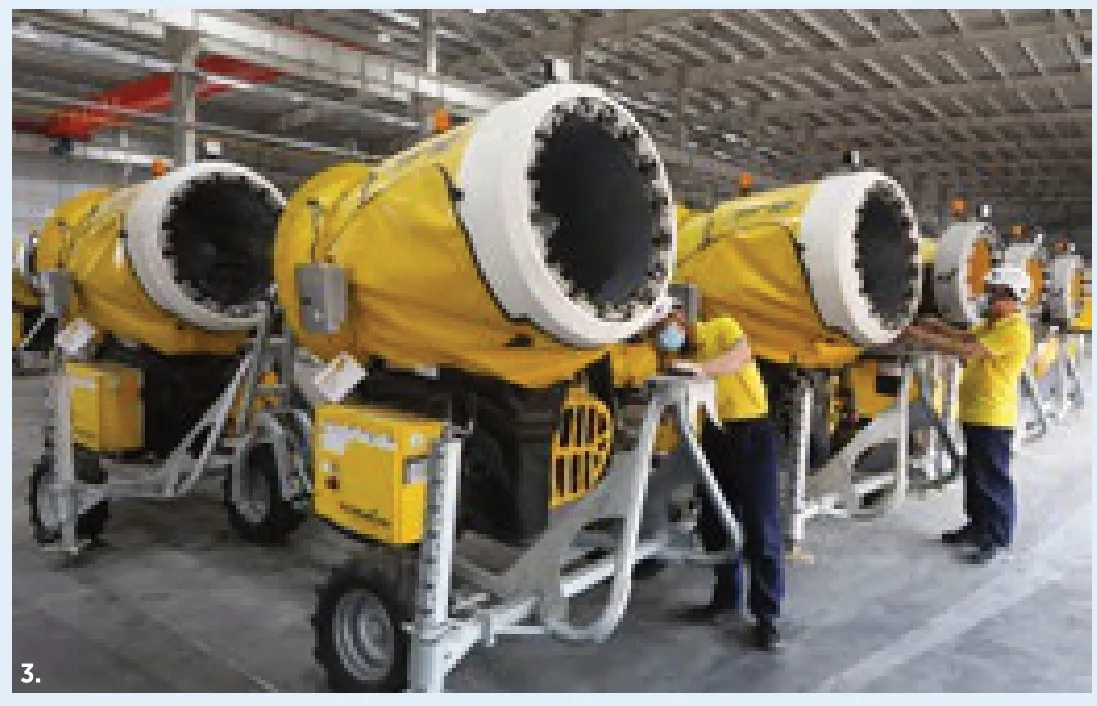BREAKING THE ICE
2022-02-21ByQiuHui
By Qiu Hui
The winter sports industry aims for sustained growth after the Winter Olympic Games
After Beijing was chosen to host the 2022 Winter Olympic Games on July 31, 2015, winter sports started gaining traction among the general public in China, jumpstarting the winter sports economy.
In winter 2015, the Chongli Skiing Resort in Zhangjiakou, a co-host of the 2022 Olympic and Paralympic Winter Games, opened for its first snow season after Beijing was awarded the Winter Olympic Games.Chongli, the seat of a former impoverished county,welcomed over 2 million visitors during the season and earned 1.4 billion yuan (US$215 million) in direct revenues.
Over the past six years,participation in winter sports has been on the rise, according to Cheng Chaogong, chief researcher at the Tongcheng Research Institute.China’s winter sports industry quickly moved to capitalize on the opportunities created by the grand event and the sector is now embracing unprecedented growth momentum.
2
million visitors
1.4
billion yuan
Chongli, the seat of a former impoverished county,welcomed over2 million visitorsduring the season and earned1.4 billion yuan (US$215 million)in direct revenues.
Ice and Snow Fever
China doesn’t have a strong winter sports tradition, which was an admitted weak point of the bid.Consequently, in its candidature file,China made a solemn commitment to the International Olympic Committee(IOC) that the award would help get 300 million people involved in winter sports.The document declared that beyond simply placing athletes front and center, China was also seeking to incorporate winter sports in people’s lives, especially teens and young adults.
China has since launched national policies to build winter sports facilities all over the country.In 2016,the State Administration of Sports released the National Winter Sports Venues and Facilities Construction Plan (2016-2022), promoting the construction of outdoor skating rinks and mobile units and encouraging the construction of removable skating rinks for parks, campuses, squares,communities, and other places.According to the plan, the country’s ice rink population was expected to more than triple from 200 in 2015 to at least 650 in 2022.The number of ski resorts should reach 800, with the total area of ski runs reaching 100million square meters and the total length reaching 3,500 kilometers.

The 23rd Harbin Ice and Snow World kicks off on December 25, 2021.(VCG)
The plan was successfully implemented.Statistics from the State Administration of Sports show that by the beginning of 2021, China had 654 standard skating rinks and 803 indoor and outdoor ski resorts, up 41 percent from 2015.
China’s winter sports facilities used to be concentrated in the north where snow and ice are abundant.Now, they are accessible to the public across the country all year round.The 2021 Winter Travel Report released by LY.com (a one-stop travel booking platform) showed that the Covid-19 pandemic caused the flow of skiers traveling northbound to decline.Ski enthusiasts in the south instead turned to local venues.Theme parks featuring winter sports have become preferred destinations for local residents.
Participation in winter sports has become an easy choice for Chinese people seeking to upgrade consumption, and the trend has created huge demand for the winter sports industry, said Cheng Chaogong.In recent years, rising per capita consumer spending and national policies aiming to promote winter sports have created a dual engine to boost the winter sports industry,according to industry insider Feng Fei.
The China Winter Tourism Development Report 2021 affirmed that the Winter Games had created new opportunities for integrated development of culture, tourism, and sports in the country.China’s ice and snow tourism is projected to reach 323.3 billion yuan (US$59.9 billion) in the 2021-22 season.
65o 8oo1oo
million square meters
3,5oo
kilometers
According to the plan, the country’s ice rink population was expected to more than triple from200in 2015 to at least650in 2022.The number of ski resorts should reach800, with the total area of ski runs reaching100 million square metersand the total length reaching3,500 kilometers.
Young and Enthusiastic
Ice and snow sports have distinct appeal, said Feng Fei.From the perspective of participation, snow sports are often closely linked to tourism and favored by young adults,while ice sports are more popular with teenagers.Compared to snow sports consumers, ice sports consumers are more likely to make repeat purchases.
An industry insider for more than 10 years, Feng has witnessed a steep increase in the number of children hitting the rinks with support from their parents.

654
standard skating rinks
8o3
indoor and outdoor ski resorts
Statistics from the State Administration of Sports show that by the beginning of 2021, China had654 standard skating rinksand803 indoor and outdoor ski resorts, up41 percentfrom 2015.
The document declared that beyond simply placing athletes front and center, China was also seeking to incorporate winter sports in people’s lives, especially teens and young adults.
“Ice hockey is a good example,” said Feng.“In 2009, only 40 children were engaged in systematic ice hockey training in Beijing.Twelve years later,nearly 10,000 ice hockey players are registered in the city.” Since the successful bid for the Winter Games,China has been actively promoting winter sports in schools, which has resulted in millions of teens becoming involved in ice sports.
Every year since 2015, 5,000 kids from 25 schools have participated in ice skating classes at Shanghai Feiyang Ice Sports Center, China’s first commercial ice skating stadium,according to Yang Yang, its founder.Feiyang Club now offers coaching on short-track speed skating, ice hockey,and figure skating to more than 30 schools in Shanghai.
In contrast to the ski resorts usually found in the suburbs, skating rinks are usually built in stadiums or commercial streets in central urban areas.On weekends, rinks are usually crowded with trainees and surrounded by parents.
At the Wukesong Huaxi HI-ICE Ice Park in western Beijing, some children were practicing skating on a weekday morning in December 2020.A manager said that the park hosts an average of 10,000 visitors every month.After trying out the ice, some choose to join training courses or other organized activities.
Not far from HI-ICE is the Wukesong Ice Sports Center, the first operational carbon dioxide ice rink for the Winter Games.In May 2021,the center was officially inaugurated as the ice hockey training stadium of the Winter Games.Today, Feng Fei is responsible for management and operation of the center.He said that after two months of trial operation,200 students had registered for training programs at the center.“I think more people will train here after the Winter Games,” he added,predicting that next year at least 500 people would join ice hockey classes and 3,000 would register for figure skating programs.
Zhao Yan, chairman of Huaxi Group, said her company, owner of the Wukesong Ice Sports Center, will carry on the legacy of the Winter Games.The center will open to the public as a complex of commercial and winter sports facilities in April 2022, a month after the Winter Games conclude.To meet people’s needs for winter sports, Zhao’s company plans to develop innovative products and services, promote integrated development of the winter sports and entertainment industries, and build a complete industrial chain serving cultural and sports industries.
Ye Tanglin, executive vice president of the Mega City Research Institute at Beijing-based Capital University of Economic and Business, said that primary and secondary school students’ early involvement in winter sports helps improve public participation and the winter sports industry, which drives the growth of the related industries, including tourism, catering, and entertainment.
However, the foundation for winter sports in China remains relatively weak,according to Ye.Increased investment in winter sports has been decent at the early stage.But as the Winter Games draw near, the long-term and efficient use of relevant infrastructure has become a prominent issue for the industry in the medium term.Ye said that since the Winter Games venues are located in Beijing and Hebei Province,the Beijing-Tianjin-Hebei region’s winter sports industry stands to benefit most.Nonetheless, Ye cautioned against a potentially overheated market and reckless expansion.Typically, most winter sports customers live within a certain radius of sports facilities and theoretically, there is a distance limit for loyal customers.In addition,consumption frequency is difficult to predict.
New Opportunities
The Winter Games have brought new development opportunities for Beijing and its neighboring regions.
As the Beijing Winter Olympic Games drew near, the event already started making a big impact on the surrounding regions.It has invigorated the winter sports economy and industrial development in Beijing and Hebei Province, accelerating coordinated development of transportation,environmental protection, industry,and public services in the two localities.The Winter Games have promoted the development of the“Beijing-Zhangjiakou Winter Sports and Leisure Tourism Belt.” Winter sports have driven the development of tourism and the sports industry,which in turn have boosted regional development.
However, China’s winter sports industry is still at an early stage of development.Ye Tanglin noted that although the winter sports industry in the Beijing-Tianjin-Hebei region has accelerated over a short period of time, a complete industrial chain with upstream and downstream links has not yet formed.To foster new engines for growth in the region,especially Beijing and Zhangjiakou,forging an industrial chain with core competitiveness by making full use of the legacy of the Winter Games and boosting development of winter sports tourism and green technologies is essential.

1.Winter sports enthusiasts skate at an outdoor ice rink in Beijing on December 12, 2021. (ZHAO JUN)

2.Teenagers experience skiing at a resort in Hohhot, Inner Mongolia, on December 26, 2021. (VCG)

3.Technicians examine snowmakers at the Zhangjiakou High-tech Zone Ice and Snow Sports Equipment Industrial Park on July 7, 2021. (WU DIANSEN)

4.A technician works on a snowmobile at an ice and snow sports equipment company in Zhangjiakou on July 19, 2021.(VCG)
Compared to summer sports,winter sports have a lower consumption frequency.However,they have much room to raise market penetration and the average transaction value tends to be higher.Post-Games usage of the venues and universal winter sports education will become a driving force for the vigorous development of the winter sports economy.
In an article, tourism analyst Wang Xinlei suggested the winter sports industry reach out to culture and tourism and seek integration with environmental protection, agriculture, science,and technology.In the short term,this would boost consumption.Inthe medium term, it would drive investment and employment.In the long term, it would contribute to sustainable development, including environmental improvement,urban construction, and regional coordination.
Cheng Chaogong is optimistic about the prospects of the winter sports industry in the Beijing-Tianjin-Hebei region.He thinks that promotion of national policies,public interest in the Winter Games,and increasing awareness of winter sports have created unprecedented development opportunities in the region.
“For the winter sports economy to prosper, you have to build winter sports facilities for tourists,” he said.“But securing sustained growth in the post-Games era is even more important.”
